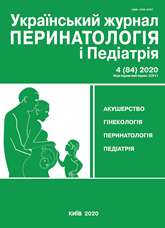External therapy of allergic dermatoses in children (literature review)
DOI:
https://doi.org/10.15574/PP.2020.84.41Keywords:
children, allergy, allergic dermatoses, external therapy, local therapyAbstract
Allergic dermatoses have a special place in the structure of allergic diseases in children due to their weight. The most common allergic skin lesions: simple and allergic contact dermatitis, atopic dermatitis, various forms of eczema, acute and chronic allergic urticaria, Quincke's edema, multiforme exudative erythema (Stevens—Johnson syndrome), acute epidermal necrolysis (Lyell's syndrome), toxicodermias, as well as less common dermatoses, in the pathogenesis of which are leading allergic reactions. Despite a number of research research, the difficulties in the determining of the therapeutic approach of allergic dermatoses in children are still observed. According to the international program documents EAACI (European Academy of Allergy and Clinical Immunology), AAAAI (American Academy of Allergy, Asthma & Immunology), PRACТALL (Practical Allergology Consensus Report) in treatment of allergic dermatoses the leading place takes external therapy, which requires an individual approach and daily care of skin. External therapy consists of local application of emollients, topical glucocorticosteroids, topical calcineurin inhibitors, topical antihistamines, keratolytic, keratoplastic, reparants, epithelializing and anti-inflammatory medications, in the case of complicated clinical course of the disease — antibacterial, antifungal, antiviral medications, also with skin care.
Purpose — to increase information on modern possibilities of external therapy of allergic dermatoses in children.
External pharmacotherapy of allergic dermatoses should be etiopathogenetic and should affect on the mechanisms of allergic inflammation in the skin, elimination of itching, dryness,so finding ways to improve it will help to control the clinical course of the disease, to reduce disability, will promote to improve the life quality in patients.
No conflict of interest was declared by the author.
References
Akan A, Dibek-Misirlioglu E, Civelek E, Vezir E, Kocabas CN. (2020). Diagnosis of atopic dermatitis in children: comparison of the Hanifin-Rajka and the United Kingdom Working Party criteria. Allergologia et Immunopathologia. 48 (2): 175-181. URL: http://www.sciencedirect.com/science/article/pii/S0301054619301156; https://doi.org/10.1016/j.aller.2019.07.008; PMid:31611041
Beltrani VS. (1998). Allergic Dermatoses. Medical Clinics of North America. 82 (5): 1105-1133. URL: http://www.sciencedirect.com/science/article/pii/S0025712505704053. https://doi.org/10.1016/S0025-7125(05)70405-3
Bourrain JL. (2017). Toxicodermias. EMC - Dermatologia. 51 (4): 1-13. doi: 10.1016/S1761-2896(17)87052-7. URL: http://www.sciencedirect.com/science/article/pii/S1761289617870527. https://doi.org/10.1016/S1761-2896(17)87052-7
Dowling PJ, Kader R, Portnoy JM. (2019). COLA (Conferences On-Line Allergy) at 10 Years - Evolution of an Online Fellowship Curriculum. The Journal of Allergy and Clinical Immunology: In Practice. 7 (8): 2568-2573. URL: http://www.sciencedirect.com/science/article/pii/S2213219819305975. https://doi.org/10.1016/j.jaip.2019.06.025; PMid:31279862
Fawbert K, Leech S. (2020). Recurrent urticaria and angioedema. Paediatrics and Child Health. 30 (7): 243-248. URL: http://www.sciencedirect.com/science/article/pii/S175172222030072X. https://doi.org/10.1016/j.paed.2020.04.001
Hsu DY, Brieva J, Silverberg NB, Paller AS, Silverberg JI. (2017). Pediatric Stevens-Johnson syndrome and toxic epidermal necrolysis in the United States. Journal of the American Academy of Dermatology. 76 (5): 811-817. URL: http://www.sciencedirect.com/science/article/pii/S0190962216312853. https://doi.org/10.1016/j.jaad.2016.12.024 PMid:28285784 PMCid:PMC5502094
Millon GG, Lopez-Bran E. (2018). Toxicodermias. Medicine - Programa de Formacion Medica Continuada Acreditado. 12 (48): 2846-2853. URL: http://www.sciencedirect.com/science/article/pii/S0304541218300076. https://doi.org/10.1016/j.med.2018.01.007
Napolitano M, Fabbrocini G, Patruno C. (2019). Allergic contact dermatitis in patients with atopic dermatitis: A retrospective study. The Journal of Allergy and Clinical Immunology: In Practice. 7 (7): 2459-2461. URL: http://www.sciencedirect.com/science/article/pii/S2213219819303307. https://doi.org/10.1016/j.jaip.2019.03.045; PMid:30954642
Nassau S, Fonacier L. (2020). Allergic Contact Dermatitis. Medical Clinics of North America. 104 (1): 61-76. URL: http://www.sciencedirect.com/science/article/pii/S0025712519300884. https://doi.org/10.1016/j.mcna.2019.08.012 PMid:31757238
Nguyen V, Simon L, Jaqua E. (2016). Allergic Dermatoses. Primary Care: Clinics in Office Practice. 43 (3): 433-449. URL: http://www.sciencedirect.com/science/article/pii/S0095454316300239. https://doi.org/10.1016/j.pop.2016.04.011 PMid:27545733
Noe MH, Micheletti RG. (2020). Diagnosis and management of Stevens-Johnson syndrome/toxic epidermal necrolysis. Clinics in Dermatology. 6: 738-744. URL: http://www.sciencedirect.com/science/article/pii/S0738081X20301498. https://doi.org/10.1016/j.clindermatol.2020.06.016; PMid:33341195
Ozceker D, Haslak F, Dilek F, Sipahi S, Yucel E, Guler N, Tamay Z. (2019). Contact sensitization in children with atopic dermatitis. Allergologia et Immunopathologia. 47 (1): 47-51. URL: http://www.sciencedirect.com/science/article/pii/S0301054618301009. https://doi.org/10.1016/j.aller.2018.06.002 PMid:30193890
Downloads
Published
Issue
Section
License
The policy of the Journal “Ukrainian Journal of Perinatology and Pediatrics” is compatible with the vast majority of funders' of open access and self-archiving policies. The journal provides immediate open access route being convinced that everyone – not only scientists - can benefit from research results, and publishes articles exclusively under open access distribution, with a Creative Commons Attribution-Noncommercial 4.0 international license(СС BY-NC).
Authors transfer the copyright to the Journal “MODERN PEDIATRICS. UKRAINE” when the manuscript is accepted for publication. Authors declare that this manuscript has not been published nor is under simultaneous consideration for publication elsewhere. After publication, the articles become freely available on-line to the public.
Readers have the right to use, distribute, and reproduce articles in any medium, provided the articles and the journal are properly cited.
The use of published materials for commercial purposes is strongly prohibited.

